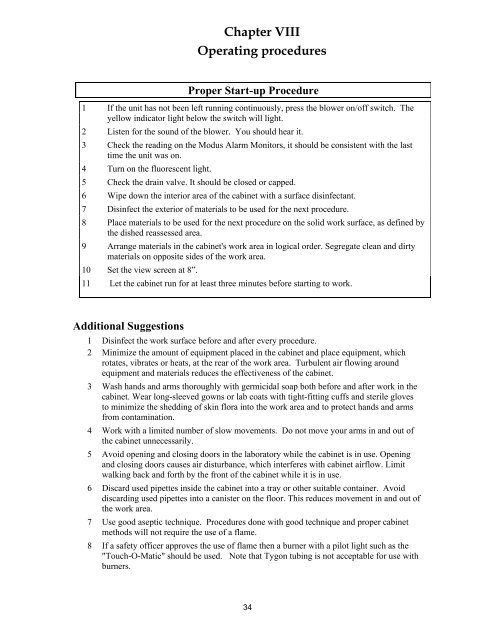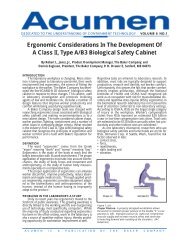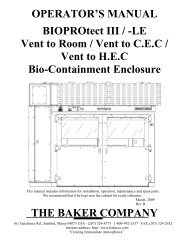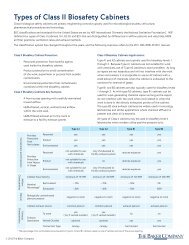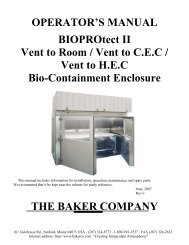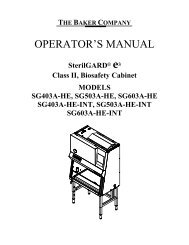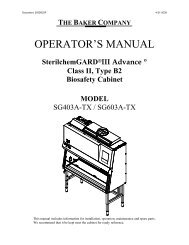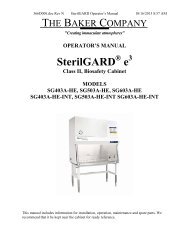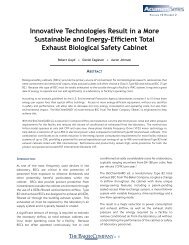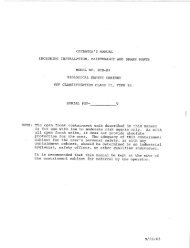SterilGARD III Advance SG403 / SG603 - Baker Company
SterilGARD III Advance SG403 / SG603 - Baker Company
SterilGARD III Advance SG403 / SG603 - Baker Company
You also want an ePaper? Increase the reach of your titles
YUMPU automatically turns print PDFs into web optimized ePapers that Google loves.
Chapter V<strong>III</strong><br />
Operating procedures<br />
Proper Start-up Procedure<br />
1 If the unit has not been left running continuously, press the blower on/off switch. The<br />
yellow indicator light below the switch will light.<br />
2 Listen for the sound of the blower. You should hear it.<br />
3 Check the reading on the Modus Alarm Monitors, it should be consistent with the last<br />
time the unit was on.<br />
4 Turn on the fluorescent light.<br />
5 Check the drain valve. It should be closed or capped.<br />
6 Wipe down the interior area of the cabinet with a surface disinfectant.<br />
7 Disinfect the exterior of materials to be used for the next procedure.<br />
8 Place materials to be used for the next procedure on the solid work surface, as defined by<br />
the dished reassessed area.<br />
9 Arrange materials in the cabinet's work area in logical order. Segregate clean and dirty<br />
materials on opposite sides of the work area.<br />
10 Set the view screen at 8”.<br />
11 Let the cabinet run for at least three minutes before starting to work.<br />
Additional Suggestions<br />
1 Disinfect the work surface before and after every procedure.<br />
2 Minimize the amount of equipment placed in the cabinet and place equipment, which<br />
rotates, vibrates or heats, at the rear of the work area. Turbulent air flowing around<br />
equipment and materials reduces the effectiveness of the cabinet.<br />
3 Wash hands and arms thoroughly with germicidal soap both before and after work in the<br />
cabinet. Wear long-sleeved gowns or lab coats with tight-fitting cuffs and sterile gloves<br />
to minimize the shedding of skin flora into the work area and to protect hands and arms<br />
from contamination.<br />
4 Work with a limited number of slow movements. Do not move your arms in and out of<br />
the cabinet unnecessarily.<br />
5 Avoid opening and closing doors in the laboratory while the cabinet is in use. Opening<br />
and closing doors causes air disturbance, which interferes with cabinet airflow. Limit<br />
walking back and forth by the front of the cabinet while it is in use.<br />
6 Discard used pipettes inside the cabinet into a tray or other suitable container. Avoid<br />
discarding used pipettes into a canister on the floor. This reduces movement in and out of<br />
the work area.<br />
7 Use good aseptic technique. Procedures done with good technique and proper cabinet<br />
methods will not require the use of a flame.<br />
8 If a safety officer approves the use of flame then a burner with a pilot light such as the<br />
"Touch-O-Matic" should be used. Note that Tygon tubing is not acceptable for use with<br />
burners.<br />
34


